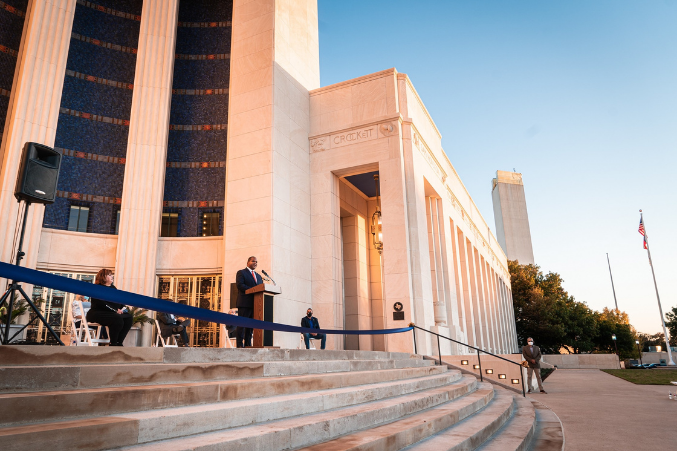Plaster was falling from the lath, the paintwork was damaged, decorative aluminum was peeling, the paint finishes on doors and windows were fading, and there was major water leakage into the basement every time a big rainfall happened—all problems that plagued Fair Park’s Hall of State building, a centerpiece of the 1936 Texas Centennial Exposition.
Several years ago, Dallas architecture firm Gensler was enlisted to repair the crumbling facility and this month unveiled the results of a three-year $14.4 million renovation made possible by a 2017 bond package approved by Dallas voters.
D CEO spoke with project architect Felicia Santiago to learn more about the process.
Santiago explained the process began with a building assessment in 2018, which revealed humidification problems that were a continuation of issues attempted to be solved 10 years prior. “Water is such a killer for all buildings,” and within the interstitial space of the Hall of State, where all of the HVAC ductwork condensation lines run, there was a constant dripping of condensation moisture onto the plaster ceilings.

There was moisture all within the building and at the ground and basement level as well. Gensler noticed the grading around the building was not properly guiding water away from the building, which in theory would protect the building. To solve these problems, Gensler accepted the aid of the MEP mechanical engineers and a building envelope engineer to address the structural aspect of the deterioration due to the water.
In restoring these problem areas, they first removed the old condensing unit and let the building dry out for two months before updating the ductwork and installing pans underneath to serve as double protection if anything were to leak again in the future.
Once the general contractor, Phoenix 1 Restoration, was on board, Gensler began the very detailed-oriented process of restoring the building as the Hall of State is a state antiquities landmark in Texas and is recognized as one of the biggest and best examples of art deco in the nation. For the restoration to be historically correct, Gensler sourced identical materials to those used to build in 1936.
The stone that was used was sourced from Dee Brown, Inc., and is the same Texas limestone that was originally used for the building—the color, texture, and size had to be a match. Additionally, one of Gensler’s “biggest allies,” as Santiago puts it, was the art conservator, van Enter Studio, who did the paint analysis. Jhonny Langer, with SOURCE Conservation, took samples from the building, took them to a lab, and from there, he was able to tell Gensler the specific paint colors used in 1936.
Everything, in addition to accessibility ramps, was done to maintain the integrity of the building.
Previously Governor Abbott had come to visit the Hall of State, but due to the only accessibility ramp being located in the back and his wheelchair not being able to fit through the door, he had to be carried up the steps, which you can imagine is not the most flattering or comfortable means of entry. To remedy this predicament, Gensler coordinated with the Texas Historical Commission, Dallas landmark, and the Office of Cultural Affairs to get a design approved.
While the only new construction was the ramp, great care was taken to ensure cohesion in design and materials.

The bronze handrails are consistent with the bronze material that’s used on the building, the stone is the same limestone that Gensler used for the patching material and new stone that needed to be applied to the building, and the concrete pathway on the ramp is the same concrete appearance as the restored concrete pavement in the courtyard. And in terms of design, the walls of the ramp are the same height as existing walls and colonnade floor, and the handrails were inspired by the only existing guardrail that’s on-site, which is located at the back of the building where the old entrance to the restrooms was, which at the time were segregated.
So when viewing the building, the restored areas are seamless and have brought the Hall of State back to its former glory.
Perhaps the greatest and most prominent restoration was to the grande bronze doors that lead into the building. The process took great coordination from several artists and required a local glass artist to slump the glass to fit perfectly into the niche, which is something unheard of.
Additionally, Gensler and the artists referenced historic black and white photographs to determine the nature and color that the bronze should be, which resulted in agreeance over its depth and sculptural aspects.





